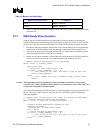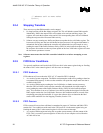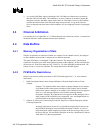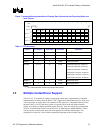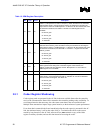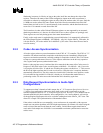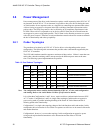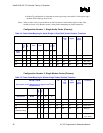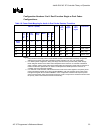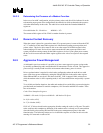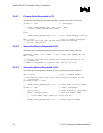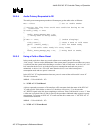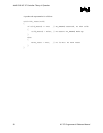
Intel® ICH5 AC ’97 Controller Theory of Operation
R
AC ’97 Programmer’s Reference Manual 31
Configuration 5 is a two-codec audio topology. In this configuration concerns are on the proper
power down sequence. However, no driver interaction is expected as only the audio driver
executes power management functions.
Configuration 6 is also a two-codec topology with split audio and integrated modem support. This
is the most complex interaction, as two different sets of driver will be operating in a complex
topology.
Configuration 7 is identical to configuration 6, with the primary and secondary codecs switched.
In order to power manage ICH5 AC ’97 codecs, there are two sets of PR bits that drivers need to
manage. One set is at offset MMBAR + 26h in the audio function, mapped to offset 26h in the
primary codec, and the second set is at MMBAR + 3Eh, mapped to offset 3Eh in the modem
function. Notice that register 3Eh does not provide link down functionality, this is provided in
register 56h bit 12, (MLNK) modem link.
3.6.1.1 Tertiary Codec Topologies
Table 12 lists configurations using a primary and secondary codec. ICH5 also supports
configurations involving a third (tertiary) codec. It is important to note that three codec
configurations are an extension of the corresponding two codec versions and have the same D3
interactions and issues. Therefore, the configurations, algorithms and pseudo-code described for
the secondary codec also apply and can be used for configurations that involve three codecs.
3.6.2 Power Management Transition Maps
The following paragraphs relate power management transition maps in the constraints of an ACPI
system environment. The tables below map codec PR bits transitions to specific ACPI “D” states
for the device.
The following considerations were made in the generation of the following tables:
• Power management is defined in the framework of a desktop system. Further power savings
are possible by implementing more aggressive power management typical of mobile
environment policies (see aggressive power management section below). However these
power savings are a trade off involving driver complexities and functional restrictions.
• Selection of a specific power policy below is pending the proper identification of the topology
by the driver(s).
• Secondary codec is provided with external clocking mechanism and is not dependent on
BIT_CLK to drive internal state machines when in power down mode.
• After warm or cold reset the device driver will bring all PR(x) bits to D0 state.
• Transition from/to any Dx state is accomplished by setting/resetting all appropriate PR(x) bit
simultaneously. Codec should not place limitations on the PR(x) bits transition sequence
represented above.
• Audio Codec Reg. 26h D15 EAPD (formerly PR<7> enable/disable function) is newly
defined as control for an external audio power amp. Audio codec should provide an audio
amp output pin (GPO) that provides off/on capability following this bit set/reset status.
• The modem tables assume Caller-ID capability during wake-up on ring, so Vref is on during
D3.



